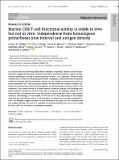| dc.contributor.author | Gilfillan, Connie B. | |
| dc.contributor.author | Wang, Chensu | |
| dc.contributor.author | Mohsen, Mona O. | |
| dc.contributor.author | Rufer, Nathalie | |
| dc.contributor.author | Hebeisen, Michael | |
| dc.contributor.author | Allard, Mathilde | |
| dc.contributor.author | Verdeil, Grégory | |
| dc.contributor.author | Bachmann, Martin F. | |
| dc.contributor.author | Speiser, Daniel E. | |
| dc.contributor.author | Irvine, Darrell J. (Darrell John), 1973- | |
| dc.date.accessioned | 2020-07-20T17:31:35Z | |
| dc.date.available | 2020-07-20T17:31:35Z | |
| dc.date.issued | 2019-11 | |
| dc.date.submitted | 2019-10 | |
| dc.identifier.issn | 0014-2980 | |
| dc.identifier.issn | 1521-4141 | |
| dc.identifier.uri | https://hdl.handle.net/1721.1/126257 | |
| dc.description.abstract | It is known that for achieving high affinity antibody responses, vaccines must be optimized for antigen dose/density, and the prime/boost interval should be at least 4 weeks. Similar knowledge is lacking for generating high avidity T-cell responses. The functional avidity (FA) of T cells, describing responsiveness to peptide, is associated with the quality of effector function and the protective capacity in vivo. Despite its importance, the FA is rarely determined in T-cell vaccination studies. We addressed the question whether different time intervals for short-term homologous vaccinations impact the FA of CD8 T-cell responses. Four-week instead of 2-week intervals between priming and boosting with potent subunit vaccines in C57BL/6 mice did not improve FA. Equally, similar FA was observed after vaccination with virus-like particles displaying low versus high antigen densities. Interestingly, FA was stable in vivo but not in vitro, depending on the antigen dose and the time interval since T-cell activation, as observed in murine monoclonal T cells. Our findings suggest dynamic in vivo modulation for equal FA. We conclude that low antigen density vaccines or a minimal 4-week prime/boost interval are not crucial for the T-cell's FA, in contrast to antibody responses. | en_US |
| dc.language.iso | en | |
| dc.publisher | Wiley | en_US |
| dc.relation.isversionof | http://dx.doi.org/10.1002/eji.201948355 | en_US |
| dc.rights | Creative Commons Attribution 4.0 International license | en_US |
| dc.rights.uri | https://creativecommons.org/licenses/by/4.0/ | en_US |
| dc.source | Wiley | en_US |
| dc.title | Murine CD8 T‐cell functional avidity is stable in vivo but not in vitro: Independence from homologous prime/boost time interval and antigen density | en_US |
| dc.type | Article | en_US |
| dc.identifier.citation | Gilfillan, Connie B. et al. "Murine CD8 T‐cell functional avidity is stable in vivo but not in vitro: Independence from homologous prime/boost time interval and antigen density." European Journal of Immunology 50, 4 (April 2020): 505-514 © 2019 The Authors | en_US |
| dc.contributor.department | Koch Institute for Integrative Cancer Research at MIT | en_US |
| dc.relation.journal | European Journal of Immunology | en_US |
| dc.eprint.version | Final published version | en_US |
| dc.type.uri | http://purl.org/eprint/type/JournalArticle | en_US |
| eprint.status | http://purl.org/eprint/status/PeerReviewed | en_US |
| dc.date.updated | 2020-03-11T13:44:38Z | |
| dspace.date.submission | 2020-03-11T13:44:41Z | |
| mit.journal.volume | 50 | en_US |
| mit.journal.issue | 4 | en_US |
| mit.license | PUBLISHER_CC | |
| mit.metadata.status | Complete | |
